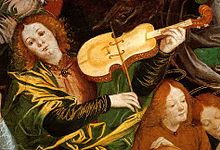Viola da braccio


Viola da braccio ("arm violin", from Italian viola "violin" and braccio "arm", plural Viole da braccio ) is the collective name for the family of violin-shaped string instruments that emerged in the 16th century . Both the name of today's viola and its Italian name Viola are derived from the original name Viola da braccio . The name refers to the arm position of these instruments in contrast to the instruments of the viola da gamba family, which are held between the knees. An exception is the viola da braccio bass instrument, which is also held between the knees, but without floor support and "sting" as is the case with today's violoncello .
Viola da braccio and viola da gamba
The families of the viola da braccio and the viola da gamba differ both in terms of construction in size and shape, the string tuning ( viola da braccio in fifths tuning - viola da gamba in fourths tuning) and in terms of playing technique ( viola da braccio = arm position, exception : Bass viola da braccio - viola da gamba = knee position with floor support) as well as in the bow position ( viola da braccio = upper bow grip - viola da gamba = lower bow grip).
History and Development
Over the centuries in the history of the violin and gamba families, there has been a constant further development up to the present-day form of the modern instruments known to us as the violin / violin, viola / viola and cello. The double bass, however, developed from both the violone and the bass viola da gamba .
The first instruments of the viola da braccio family were built in Italy from around 1530.
After the early form with three strings , the four-string instrument developed into one without string frets with a tuning in fifths . In this family, instruments of various sizes and moods are called soprano, alto, tenor and bass viola da braccio .
The alto instrument in the tuning c - g - d 1 - a 1 is comparable to today's viola. In the 16th century, the tenor viola , like the alto viola , was initially tuned to c - g - d 1 - a 1 and later lower to G - d - a - e 1 . The Soprano Viola with their mood on g - d 1 -a 1 - e 2 corresponding to the current violin / violin. The bass instrument with the tuning on B '- f - c - g then developed more and more into today's violoncello with the string tuning C - G - d - a.
Web links
Individual evidence
- ^ History of the Viola in History - Vienna Symphonic Library. Retrieved November 29, 2018 .
- ↑ a b History of Bass Instruments in History - Vienna Symphonic Library. Retrieved November 14, 2018 .
- ^ FA Brockhaus (Ed.): Brockhaus Musiklexikon .